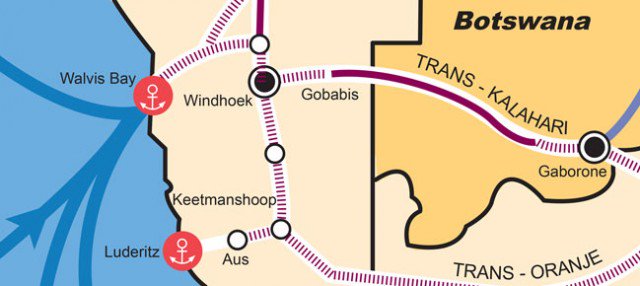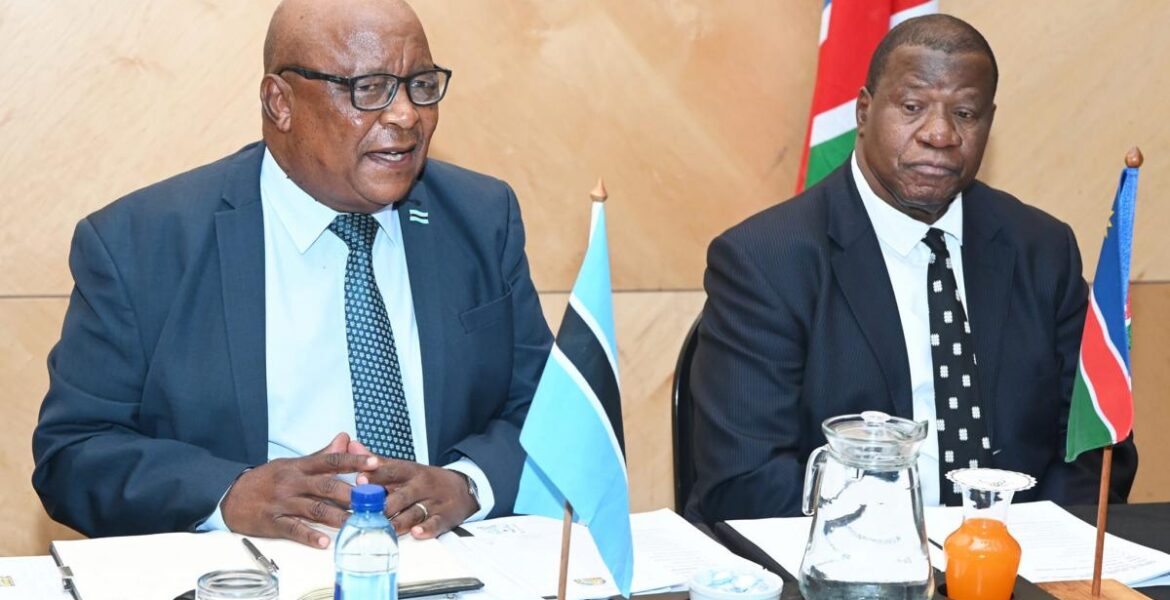For the TKR to make sense it must no longer be thought of as a transport project but a
national and regional development project
DOUGLAS RASBASH
The Governments of the Republic of Botswana and the Republic of Namibia, having the desire to unlock their economic potential through trade expansion and the development of tourism, undertook to develop a railway line from the coal fields in Botswana to a port in Namibia. Subsequently, the two governments concluded a Memorandum of Understanding on November 30th in Windhoek. The MoU was signed by Hon Mutorwa of Namibia and Hon Eric Molale for Botswana. In the signing ceremony both Ministers affirmed their commitment to the development of the TKR Project.
MoU
The MoU resolved to i) Capacitate the TKR project management project office ii) Establish a joint technical team and iii) Approve an operational budget to advance the project. The latest move is for the call for expressions of interest in September 2023, from private consortia for the DBOOT of the TKR. There have been several MoUs over the years for the TKR some of which the author has attended in 2003, 2009, 2014, 2016, 2018 and 2022. In 2011, the World Bank conducted a prefeasibility study that was not positive about the economic viability. Following the conclusion of the Project Management Office Agreement, in 2015, the two Governments began the process of setting up and operationalising the Project Management Office, located in Windhoek, Namibia, in order to facilitate the implementation of the project. Having due regard to the very protracted history of the TKR this feature explored what needs to be done to make better progress this time around.
Project Description
What has attracted transport planners and engineers to the TKR is a very low unit operating cost. This is due to the flat gradient from Botswana to the seaboard that will allow 200 wagon trains trailing 8,400 tons. Whereas the routes to the Indian Ocean are bedeviled by the topography which considerably limits the train length and increases the unit costs pro-rata. The TKR Project entails the development of an approximately 1500km Cape Gauge railway line commencing from the Mmamabula coal fields in Botswana, through the Botswana-Namibia border into a coal handling terminal and associated loading facilities in Walvis Bay, Namibia. The TKR Project involves the movement of coal and other commodities along the railway route alignment, with coal being the anchor commodity. The two Governments had previously resolved to develop the Project through a Public-Private Partnership modality based on a Design, Build, Own, Operate and Transfer (DBOOT) contractual arrangement with the developer.
Risks and challenges
A study carried out in 2016 identified all the risks and challenges associated with the Project, the main challenge being the then low price of coal which rendered the project non bankable. The study further developed mitigating factors to address the challenges and recommended that the Governments should show commitment to the project, while waiting for coal prices to go up, by undertaking to resolve those project risks that are within their control such as i) optimising and purchasing the railway route alignment, ii)dealing with cross border regulations; and iii) dealing with wildlife and stock management along the route alignment.
Price of Coal
Critical to the economic and financial feasibility of the TKR railway project is the global price of coal. At the time the first study was done in 2010 the price of coal was $114 per ton. The price of coal in 2016 was around $40 per ton. The diagram below clearly shows the price of coal (dark brown line) was well below the cost of production plus transport costs (light brown line) and was predicted to remain below this threshold for years to come.
However, the war in Ukraine has spiked the price of coal to an incredible $445 per ton in 2022. If this high price is sustained, then there most certainly would be a good chance of investment being leveraged from the private sector. However, the coal price today of $159 per ton is considerably lower than its highs but higher than forecasts used in 2016. The coal price renaissance is being watched carefully and plays a massive role in the risk analysis of the TKR.
Furthermore, concerns regarding global warming and the combustion of fossil fuels, which has depressed the outlook for coal prices may again do so once the Ukraine crisis is resolved. The phasing down or even phasing out of coal is indelibly inked on the international agenda. Copper exporting has also been linked with the feasibility of the TKR, but the exporting of copper ore rather than value added products should be anathema to the government and not be used to help justify the rail investment. The Khoemacau Mine predicts production of 130,000 tons of refined copper, which though very important, is not sufficient to justify investing in the TKR. Indeed, with the rapid expansion of Pan African Trade, should Botswana even be planning to export minerals to its traditional markets in the long term? Given the volatility of the price of coal and restructuring of the global economy – including Africa, another way forward is recommended; the project needs to be rebranded from a transport corridor to regional development corridor.
From TKR to TKCDP
It would also be very narrow-minded indeed to perceive the TKR as solely a rail transport project as it is impossible to conceive it being developed without power, water, internet and even roads. Indeed a mega project like TKR should be a development game changer for Botswana and Namibia provided leaders have the vision and MDAs capacity to realise the opportunity. A prerequisite for success will be rebranding from a railway line TKR to a development programme TKCDP – The Trans Kalahari Corridor Development Programme. This rebranding will go beyond the construction of the railway line for bulk transportation of coal copper and others, to include the development of various economic sectors such as urban development, services, mining, agriculture, manufacturing industries, real estate development, and so on. A major benefit of rebranding the project into a regional corridor development initiative is that the development of the corridor as a whole minimises the investment risk by spreading it over other related economic activities, which in turn attracts a wider range of investors. This therefore makes the development feasible and bankable, through spreading the risk between the various potential partners in different economic portfolios. In reality – the railway line would in the long term attract development to it – a bit like the Union Pacific Railway does across the United States. But instead of this happening informally and accidentally, it should be proactively planned.
Land Use and Planning Gain
When seen in the context of corridor development with concomitant cluster development, new towns and industry along its route, land use will change and also increase in value. The increase in value of land due to improvements in accessibility brought about through investment in transport infrastructure is planning gain. The area of territory influenced by the corridor is likely to be some 1500 km long by 20 km wide or 30,000 sq km. Planning gain will provide a significant source of income that could be used to offset the cost of infrastructure provided land use change is effectively planned – and regulations introduced to tax the gain. The TKR is slated as SADC regional transport corridor and has the potential to advance regional integration. Consequently, the TKR Corridor Development Project is a candidate project in the National Multimodal Transport Master Plan. The initiative is seen as a programme that contains a number of projects. These include but are not limited to a corridor development study, legislation, institution building, transaction advice, SME and cluster development planning, land use and spatial planning, hydrological mapping, town planning for new towns along the route as well as transport infrastructure design and construction.
Transport and Development Investment
Estimates for the development range between $10 and 15 billion USD. Railway infrastructure in this corridor remains a basic enabler for achieving industrial development in the region. Such mega investments are expected to have a multiplier effect on the economy overall from construction, railway / transport and logistics supply industries, and the relocation of regional activities to Botswana and Namibia.
Emphatically, partner Governments should rebrand from its original concept of being a railway development for coal and copper export to being a regional corridor development programme. Such a development programme needs to be as broadly based as possible to maximise leverage for potential investors. The broad development programme should include new cities and centres of growth points that will unlock the economic potential along the corridor. The signatories of the memorandum of understanding placed much emphasis on institutional aspects – which is correct. If the Governments of Botswana and Namibia support a broad development approach and rebrand it as the TKCDP – Trans Kalahari Corridor Development Programme, then changes will need making to the MoU and the skill set needed for its elaboration should be widened when the parties next meet.


